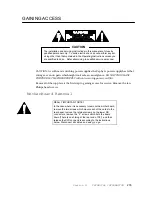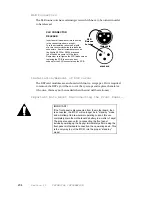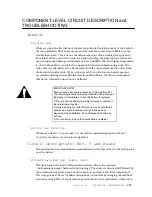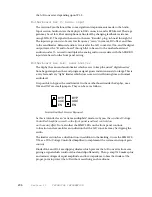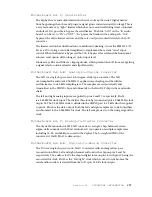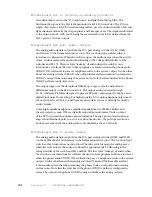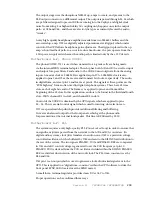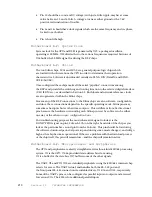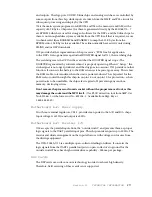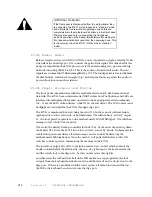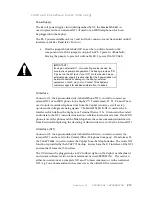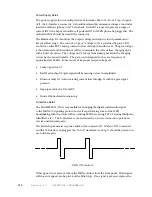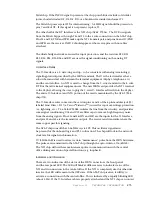
Section 11 TECHNICAL INFORMATION
217
There are four major sections of the AES/EBU card:
1.
The AES/EBU interface circuitry: U9 and U5 (CS8411) are AES/EBU receivers which
translate AES/EBU signals into the more useful three signal digital interface (clock,
data, frame- sync). U4 (CS8401) is the AES/EBU transmitter chip which generates
the AES/EBU compatible signal from the 3- wire interface. Both the receivers and
the transmitter are separated from the
outside world by transformers (T1- T4).
2.
The Sample Rate Conversion circuitry: U1, U2, U3, and U6 (AD1890/1) convert the
sample rates of digital audio signals from the AES/EBU signals to the those used
internally by the Zephyr, and vice- versa. The chips can be placed in the audio path
or removed as needed through the control circuitry.
3.
The Control Circuitry: U7 (PAL26V12) is used to allow the Zephyr to address the
Xilinx chip (LCA1) and the AES/EBU chips. It generates the appropriate chip select
signals for each chip according to where it is located in Zephyr memory. LCA1 is
responsible for routing the sample rate converter chips into and out of the digital
audio chain. This is accomplished by a series of switches inside the chip which are
addressed individually by the Zephyr microprocessor. In addition, the 11.28MHz
crystal is routed through the Xilinx chip to provide the 44.1kHz sampling rate not
normally supported by the Zephyr.
Connector Descriptions
1.
AES- IN: This is the XLR connector for the AES/EBU input from a digital audio
source. The Zephyr can automatically adjust the sample of the incoming signal to
match the internal Zephyr clocks, or this function can be bypassed if the AES/EBU
signal is already synchronized to the digital network.
2.
AES- OUT: This connector is used to provide the AES/EBU output signal from the
Zephyr receive path. The audio is identical to the Zephyr analog output, but the
sample rate is programmable.
3.
SYNC- IN: This is used to provide an external AES/EBU signal which the Zephyr can
then be synchronized to. Primarily for studios with a master clock, this connector
accepts any AES/EBU signal, and uses only the clock.
4.
SYNC- OUT: An AES/EBU output that is simply the SYNC- IN routed back to the
outside world. This is useful in daisy- chaining several AES/EBU compatible devices
with one SYNC signal.
Power Supply
The power supply has a universal AC input, accepting a continuous input range
of 100- 240VAC, 50/60Hz. Its outputs provides three separate voltages: a +5V supply
which powers all the digital circuits, a ±12V output supplies basic audio circuits and is
further regulated on the motherboard to ±5V for critical audio functions like the A/D
and D/A sections. A separate small linear regulator supplies the critical PLL power.
Summary of Contents for Zephyr
Page 13: ...Table of Contents 13 SECTION 1 QUICK RESULTS ...
Page 26: ...Section 2 INTRODUCTION 26 This page intentially left blank ...
Page 27: ...Section 2 INTRODUCTION 27 SECTION 2 INTRODUCTION ...
Page 38: ...Section 2 INTRODUCTION 38 This page intentionally left blank ...
Page 39: ...39 SECTION 3 ZEPHYR AT A GLANCE ...
Page 52: ...Section 4 INSTALLATION BASIC OPERATION 52 This page intentionally left blank ...
Page 53: ...Section 4 INSTALLATION BASIC OP 53 SECTION 4 INSTALLATION BASIC OPERATION ...
Page 84: ...Section 4 INSTALLATION BASIC OPERATION 84 ...
Page 85: ...Section 5 ISDN 85 SECTION 5 ISDN ...
Page 105: ...Section 6 NON ISDN NETWORKS 105 SECTION 7 AUDIO CODING ...
Page 118: ...Section 7 AUDIO CODING PRINCIPLES 118 This page intentionally left blank ...
Page 119: ...Section 8 DETAILED MENU REFERENCE 119 SECTION 8 DETAILED MENU REFERENCE ...
Page 157: ...Section 9 REMOTE CONTROL 157 SECTION 9 REMOTE CONTROL ...
Page 176: ...Section 9 REMOTE CONTROL 176 This page intentionally left blank ...
Page 177: ...Section 10 ADVANCED PROBLEM SOLVING 177 SECTION 10 ADVANCED PROBLEM SOLVING ...
Page 196: ...Section 10 ADVANCED PROBLEM SOLVING 196 This page intentionally left blank ...
Page 197: ...Section 11 TECHNICAL INFORMATION 197 SECTION 11 DETAILED TECHNICAL INFORMATION ...
Page 219: ...Section 12 SCHEMATICS 219 SECTION 12 SCHEMATICS ...
Page 221: ...Section 13 MANUFACTURER S DATA SHEETS 221 SECTION 13 MANUFACTURER S DATA SHEETS ...
Page 223: ...Section 14 SPECIFICATIONS WARRANTY 223 SECTION 14 SPECIFICATIONS AND WARRANTY ...
Page 228: ...228 This page intentionally left blank ...
Page 229: ...Section 15 APPENDICES 229 SECTION 15 APPENDICES ...

